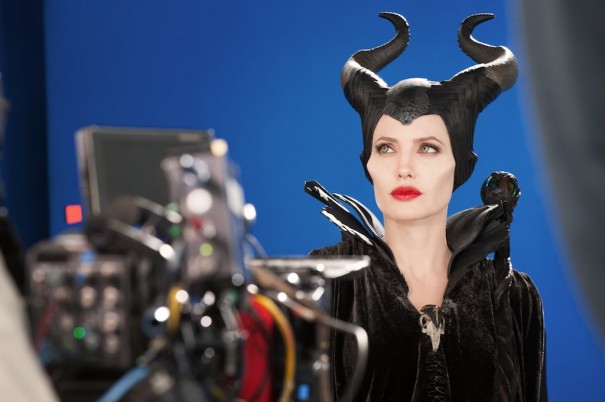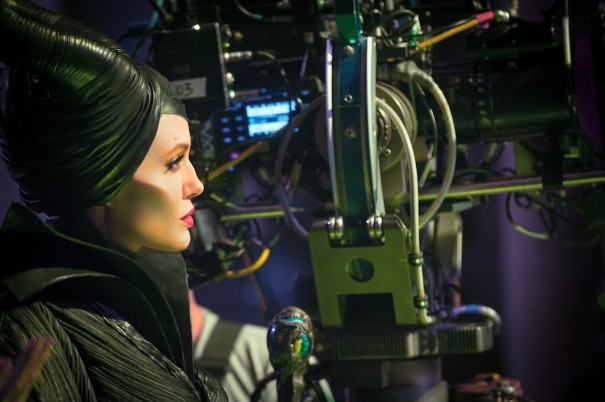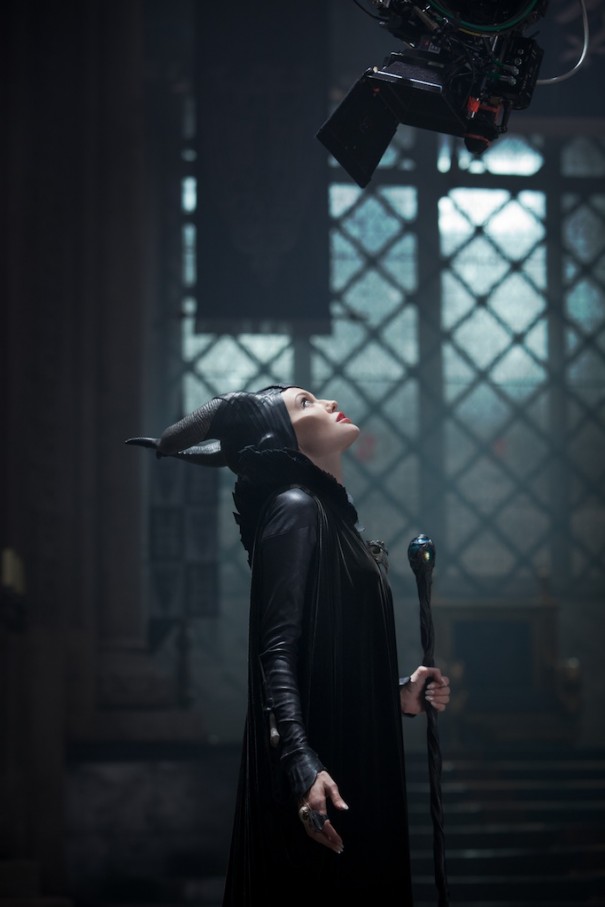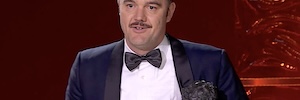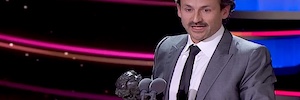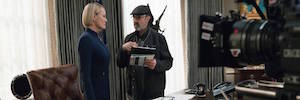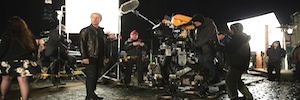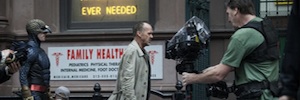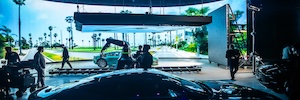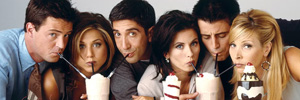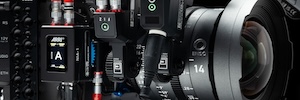Maleficent, Disney's quintessential witch, comes to life on the big screen
Shot with ARRI Alexa Plus and Studio cameras, with Panavision Primo lenses, and working in an ARRIRAW (2.8K) format, Disney premieres the big screen adaptation of the villain of the 1959 classic 'Sleeping Beauty'.
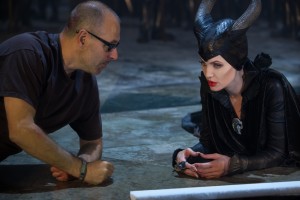 Disney premieres this weekend around the world, Maleficent, the big-screen adaptation of the villain of the 1959 classic Sleeping Beauty.
Disney premieres this weekend around the world, Maleficent, the big-screen adaptation of the villain of the 1959 classic Sleeping Beauty.
Maleficent is a beautiful young woman with a pure heart and amazing black wings. He grows up in an idyllic setting, a peaceful kingdom in the woods, until one day an army of human invaders threatens the harmony of the country. Maleficent sets herself up as the fearsome protector of her kingdom, but in the end she is the object of a ruthless betrayal that will harden her heart to stone. Blinded by her lust for revenge, Maleficent fights an epic battle with the king of humans and casts a curse on her newborn daughter Aurora as a result. When the girl grows up, she understands that Aurora holds the key to peace in the kingdom, and also to Maleficent's true happiness.
The film stars Angelina Jolie as Maleficent, Sharlto Copley, Elle Fanning, Sam Riley, Imelda Staunton, Juno Temple, and Lesley Manville.
The film is produced by Joe Roth and directed by Robert Stromberg, with Angelina Jolie, Don Hahn, Matt Smith, Palak Patel, Sarah Bradshaw and Michael Vieira serving as executive producers. Linda Woolverton wrote the screenplay.
Curiosities of the shoot
Maleficent was shot with ARRI Alexa Plus and Studio cameras, with Panavision Primo lenses, working in an ARRIRAW format (2.8K). EFilm took care of the digital brokerage, while Codex technology played a prominent role in the entire workflow.
The production featured an extraordinary number of physical sets. Production designers Gary Freeman and Dylan Cole, along with set decorator Lee Sandales, worked with Stromberg to create exterior and interior backdrops to match this great epic. About 40 sets were built, from a room of 1.10 m2, to the Great Hall of 460 m2.
The castle is a physical recreation, both inside and outside, of the castle from the 1959 animated film. It is grandiose with marble floors and 16th-century materials and finishes and is furnished with antiques. It took 14 weeks to build, employing 250 workers, and an artistic department of 20 people.
Ricky Baker, winner of seven Oscars, headed the special makeup effects department. He was in charge of Angelina Jolie's horns and cheekbone prostheses as well as other special character makeup. Baker and his team sculpted three different sets of horns based on Maleficent's original look in the animated film. The horns are made of a urethane resin, a lightweight and durable material. To make all of Angelina Jolie's prosthetics fit the angles of her face, the team made a mold of her head and made rubber cheeks and ears following those contours. In the case of Angelina Jolie, four hours a day were invested in placing the prosthesis.
The production used motion capture technique for the three Fairies (Imelda Staunton, Juno Temple and Lesley Manville) when they were filmed in their original size of 53 cm to capture all the nuances of the talent of the three actresses. The visual effects team used 150 markers on each of the faces to reproduce their facial expressions on the computer-generated characters. These funny characters were slightly caricatured in the 53 cm size, with larger heads and their natural silhouettes were exaggerated so that they did not look like normal people reduced to 53 cm in height.
Getting the perfect look for the live-action film was very important to both director Robert Stromberg and Angelina Jolie. "Angelina was not only fascinated by the character but also by the way she looked," says Stromberg. "We worked together to get a character that wasn't a stereotypical image, but it was also imperative that the audience immediately recognize Maleficent."
The job of recreating Maleficent's costume from the animated film fell to costume designer Anna B. Sheppard, known for her work on "Schindler's List" and "The Pianist," which earned her Academy Award nominations. The costume designer had to create two very different worlds, one with creatures that live in a fairy forest and another that is a human kingdom. Sheppard began his research by studying 15th-century, French and Italian Renaissance art in paintings, sketches, and sculptures.
The look of the character of Maleficent that appeared in the 1959 animated film was the work of animator Marc Davis, to whom we owe Maleficent's horns and elegant style with flowing capes and high chokers. So Sheppard started with these references to find Maleficent's appearance. After watching "Sleeping Beauty," Sheppard added the design elements and says, "The character that comes from that movie is Maleficent. I used colors that look like the Disney movie. I think that in the great baptism scene, Maleficent's appearance is what everyone expects. She's the Maleficent of the animated version, only much more beautiful."
The costume designer points out: "Maleficent's costumes evolve from moss green tones and 'ethereal' fabrics to dark colours and sculptural shapes with much heavier fabrics with a lot of volume. Artificial fur and feather accessories created by specialist designers were used to give the character a much darker and more sinister look."
One of the first elements to be created was Maleficent's horns and facial contour as they were imperative to creating Maleficent's distinctive style. Rick Baker, the seven-time Oscar-winning® makeup special effects designer, joined this process. Baker immediately began with a digital painting in which she reproduced her vision of Maleficent's look. "I thought about Angelina Jolie, and I didn't want to overload her. In my opinion, you should add horns and ears and not do anything to your face," says Baker.
But the design underwent certain transformations with the ideas that Angelina Jolie contributed. As Baker explains, "Angelina wanted to wear prosthetics, so I made some designs with prosthetics that were subtle. She also wanted a nose that would reinforce Maleficent's look. In the initial phases, we created many combinations of cheeks, ears, and horns. First we made sketches and then we sculpted them in a mold of his head and made prototypes for him to review."
Baker created silicone and gel-filled prosthetic cheeks, noses and ears for Jolie. In the film, Maleficent's cheeks are very marked, but the truth is that the prosthetics are very small. Baker explains: "It's incredible because the maximum thickness of the prostheses is 6.35 mm and 1.27 cm wide. They are placed in the most prominent part of his cheekbones."
When it came time to make the horns, Baker faced several challenges. "The horns posed the biggest problem because no one wants to spend the day with huge horns on their head," Baker says. "So I wanted them to be as light as possible and also detachable because when you're wearing an object on your head that protrudes 30cm and you're not used to it, you're sure to spend the day bumping into things."
Baker and his team sculpted a minimum of four different horn designs. "I did some drawings and also molded horn designs on the computer," Baker says. "Then we sculpt them. We chose the one we liked the most and did all the work based on that single design."
The good thing is that the horns are very light and thin and are made of a urethane resin. "After a lot of experimentation, we ended up with a large skullcap that had the base of the horns and the first 2.5 centimeters of the horns incorporated," explains Baker. "The rest of the horns were attached with a magnet. They were very strong magnets that held them perfectly and allowed us to remove them when not filming."
The green skin that Maleficent has in "Sleeping Beauty" does not exist in the live-action version of "Maleficent". "But we wanted it to be beautiful and attractive," Baker says. "It was very important because we didn't want it to look like a fictional creature. We wanted him to look as realistic as possible in this film."
Baker also used contact lenses to complete Jolie's Maleficent look. "Angelina designed them," Baker says. "An artist who is an expert in that field hand-painted the lenses. I work with a person who always makes them for us. We had some photos of the eyes and made them a little bigger."
After designing and crafting the horns, hatter Justin Smith joined the design to line the horns and headdress worn by Jolie's Maleficent. The first thing he did was study the costumes that Anna Sheppard had created for the character. He then contributed his innovative ideas to the creation of an iconic look based on the original character from the animated film. Explaining his ideas, Smith comments: "Angelina was always the muse and I created several headdress designs for them. The designs were based on the story of Maleficent, i.e. the fact that she has horns. I designed and created looks that reflected the tension between the terror it inspires and the magical element. The result was a contemporary haute couture version of the animated version from the 50s."
Smith consulted with Angelina Jolie, the star of the film, to come up with the basic design of the headdresses. "Angelina wanted something that would completely cover her head and cover all her hair. But I didn't want it to look like he was wearing a turban on his head. So I immediately understood what she wanted and we began to create an identity for her. We started working with exotic skins.
"There is python skin, very fine leather and also fish skin. It's all based on clean, simple silhouettes and a technique that allows them to be easily placed around the head," Smith concludes.
To create his designs, Smith used existing references. "It's clear that there's a theme that we had to build on and have the fabrics that had already been chosen," Smith says. "So I looked at the materials I could use to fit in with the rest of the wardrobe. I brought my own techniques and the modern style of millinery that characterizes me. Many of my references are artists like Michael Parkes, who is one of my favorites, especially his beautiful lithographs so elegant. I also gathered information in some books about knots and others that I usually use for my work."
Using all these resources, Smith adapted his techniques and ideas to the costumes. "I tried to do something that I hope will be new and somewhat avant-garde, with a futuristic touch. But I didn't want it to be scary or too attention-grabbing," Smith explains. "It's more about complementing the overall look so that everything is harmonious."
Smith used history to guide him, using his numerous references to animals and creatures from the forest kingdom and brought some influences from the animal kingdom to Maleficent's look. "The idea was that the headdresses would have no structure, no seam," explains the milliner. "They look very handmade, as if they were skins and materials from the forest. It's as if Maleficent has wrapped her head around them. The idea was that they would look very natural and not at all contrived."
Smith created six different headdresses that correspond to the seasons to specific scenes. Describing some of the looks, Smith states, "There's a summer look that's a python skin headpiece. At the baptism he wears a leather turban with leather-lined spines. We also have a spring look which is a sewn leather ribbon that creates a fluted effect and then painted and lacquered. There is the spiked stripe headdress. The stripe is on the top and the leather on the sides."
[youtube]https://www.youtube.com/watch?v=guZJMgCatiM[/youtube]
Did you like this article?
Subscribe to our NEWSLETTER and you won't miss a thing.



